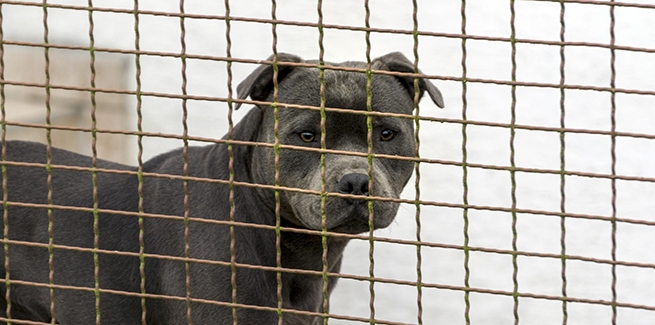Genetic testing shows animal shelters often get breeds wrong . . . and not always by mistake

He sure looks like some kind of pit bull terrier, but the shelter says otherwise.
If you go to a shelter to adopt a dog and ask an employee what breed he is, your guess is as good as theirs. In fact, yours might be better. Because sometimes they guess wrong.
Deliberately.
A 2013 study of how shelter employees identify dog breeds found that 41% of shelter employees in areas with breed-specific legislation (BSL) indicated that they would knowingly misidentify a dog if he looked like he might be a restricted breed, presumably to increase his chance of adoption. BSL is a blanket term for laws designed to reduce dog attacks on humans and other animals by banning or regulating so-called dangerous breeds such as pit bulls.
Specifically, the study asked, “If the dog in question is a cross or mix, would your shelter ever classify it as a breed that is not banned? For example, if [pit bulls] were illegal where your shelter is located, might your shelter label a dog that may be a Labrador and [pit bull] cross (mix) as a Labrador cross (mix)?”
Almost two fifths of participants said they would intentionally label a dog thought to be a mix of a banned breed as a breed that is not banned.
One participant who thought one of the dogs looked like a cross between a Labrador retriever and a Staffordshire bull terrier, said, “I would put Lab mix because they get adopted easier.”
Every year, nearly four million dogs enter animal shelters in the US. Since shelters rely on basic demographic information—including breed, age, and temperament—to market dogs for adoption, workers are left to identify strays based largely on their appearance. Mostly, it’s guesswork.
Researchers at Arizona State University’s (ASU) Canine Science Collaboratory decided to find out just how accurate that guesswork was. As part of a new study, they genotyped DNA from more than 900 shelter dogs and compared the results with the breed labels assigned to the dogs by shelter workers.
“The level of genetic diversity in the shelter dogs exceeded our expectations: We found 125 distinct breeds,” said Lisa Gunter, a doctoral student and graduate assistant in ASU’s Department of Psychology, and the study’s lead author.
The genetic diversity among shelter dogs can make it difficult for shelter staff to assess the breed heritage of dogs.
They found that, when trying to identify the primary breed in a mix, the workers got it right 67% of the time. But when they tried to identify the secondary breed, their success rate dropped to 10%.
The three most common breeds were American Staffordshire terrier, Chihuahua, and poodle. But during their stay at the shelter, dogs with pit bull–type ancestries, like the American Staffordshire terrier, typically waited three times longer to be adopted than other breeds.
And with dogs identified as being part pit bull accounting for 40% of all canine euthanasia, it’s easy to see how a shelter employee might be tempted to fudge.
Given how often shelter staff are incorrect—especially if you add in the cases where they’re mislabeling deliberately—the researchers argue we shouldn’t be labeling shelter dogs at all. Especially given how irrelevant breed identification is when it comes to behavior, which they say should be the first consideration when choosing a dog for adoption.
Clive Wynne, PhD, professor of psychology at ASU and one of the researchers, said “The genetics of behavior [are] so complex that a dog who is a cross of two breeds might not behave much like the typical members of either of its parents’ families.”
That’s why the researchers say that a dog’s behavior—how he’ll fit in with an adoptive family—should be the first consideration when adopting a shelter dog. Not breed.
“Breed labels would be better dropped altogether,” adds Wynne.
Photo credit: © iStock/Vladimira Tenzerová
NEWStat Legislation & regulation Advancements & research News Interesting/unusual



